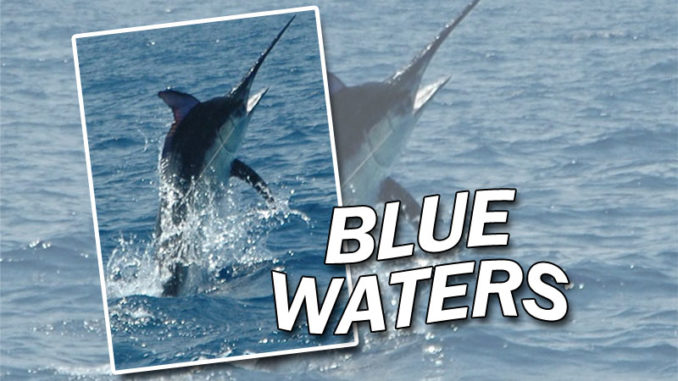
It’s a long run to the bluewater, but the billfish rewards are often well worth the ride for Charleston anglers
Charleston may be America’s most complete billfishing destination. That’s a bold statement, perhaps, but there are some definite arguments to support it.
While the waters off the Lowcountry coast may not boast the prospect of 1,000-pound blue marlin like North Carolina’s Outer Banks or the ease of kite-fishing for sailfish in South Florida, Charleston anglers enjoy consistent access to white marlin, sailfish and, best of all, good numbers of blue marlin in the warmer months.
While the run to the billfish grounds can take a few hours from the Charleston jetties, the region has a charterboat fleet for those visitors who don’t bring their own center consoles. So, if you do trailer down to do battle with the ocean’s top gamefish, you won’t be alone on your trip to the deep water.
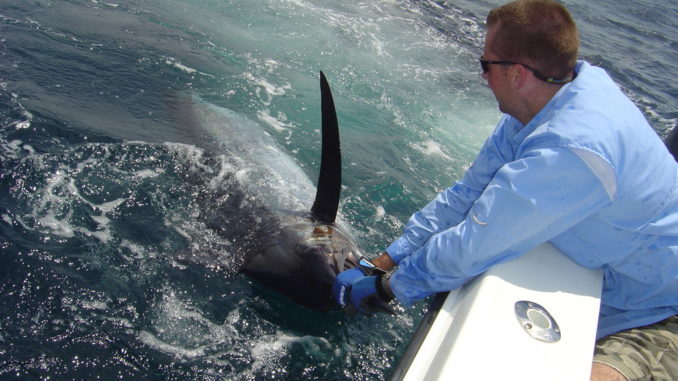
Mike Hankes of Asheville, N.C., owns a home on Daniel Island, just outside of Charleston. He has fished the area’s offshore hotspots for years, on vessels ranging from a 23-foot center console to large yachts. Through the years, he has witnessed the rise of billfishing and said that increased effort has directly led to greater and greater catches.
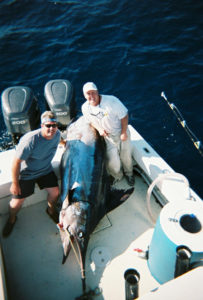
A trend towards more focus on Gulf Stream trolling began in the area 20 to 30 years ago, Hankes said, revealing a prolific fishery that was virtually ignored before. The increase in effort, he said, allowed area anglers to refine and develop their techniques, increasing their chances of success even more.
Boats from the Palmetto state have not only fared well in S.C. Governor’s Cup events, but in out-of-state tournaments was well. Charleston boats have a stellar track record in the Big Rock Blue Marlin Tournament out of Morehead City, N.C., which is perhaps the most prestigious big game tournament of all. In 2000, the Kiawah-based Summertime Blues won and set the tournament record with an 831-pound blue marlin. Since 2000, Charleston-based boats including Pipe Layer, Bak Bar and Artemis have tasted glory at that tournament as well.
Hankes said blue marlin can be caught on just about any offshore heading out of the Charleston jetties, provided you find good, clean water that has life in it. His usual spots are the 226 Hole, the Georgetown Hole, the Southwest Banks, the Ammo Dump, the Bubble Rock or the southern numbers on the Winyah Scarp. Most of these numbers are on the local charts or the waypoint chips made by ProFinder.
Hankes said he’s hooked marlin trolling between spots, so the fishery isn’t as much a numbers game as it is about being in the right place at the right time. He tends to fish a spread of Sea Witches and ballyhoo with a planer down just in case there is a hungry wahoo in the area. He has hooked blue marlin on every bait in the spread, including that planer rod, but he always keeps his biggest bait in the right short-rigger position because that’s where he gets his biggest, most-explosive bites.
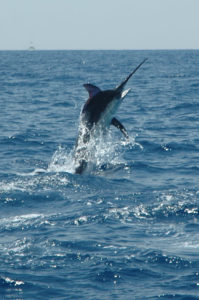
Blue marlin fishing is best during May and June, according to Hankes, but there is potential to catch them on into the late summer and fall. When the blue marlin bite is peaking, dolphin are everywhere, so don’t be surprised if you come home from a marlin trip with a box full of fresh filets as well.
While the run to the bluewater from Charleston — or any South Carolina port — is substantial, you may not have to go as far as you think. Capt. Joe Murphy, who runs the Adamada out of Shem Creek in Mount Pleasant, said he focuses specifically on depths from 150 to 300 feet, and his results speak for themselves. The Adamada is one of the more-successful billfish charterboats running out of Charleston. The boat typically spends the spring fishing in the Bahamas, so when the crew shows up in Charleston for the summer, the boat is already in mid-season form.
Murphy said that the common blue marlin technique of heading immediately to the 100-fathom line to put lines in can be a big mistake, and that those who do are often running right over and through productive water.
When the water is blue and bait is present, he deploys a spread of six rods for billfish. He biggest outfits go on the corners: 80-wides with a large lure/bait combination. When he says “large,” he means it! Often, the Adamada will use a Black Bart lure with a horse ballyhoo or Spanish mackerel behind it, rigged on a hook big enough to get penetration in the mouth of a blue. Murphy said that the shortest baits in the pattern are most attractive to the big marlin, and that a large-enough bait will keep fish coming back, just in case they don’t get hooked on the first bite.

On the short rigger, he runs 50-wides with an Ilander/ballyhoo combination. These baits are pulled just in front of the teasers, which are run from the bridge. Finally, the long riggers are 30-wide outfits with smaller baits, such as a Mold Craft softhead/ballyhoo combination. These baits usually pick up sailfish and white marlin, but the 30-wides can handle a small or medium-sized blue if the angler and captain react quickly enough. Trolling speed is six to eight knots, depending on sea conditions, and hooks are always filed to razor sharp.
Capt. Dan Woody is another blue marlin aficionado who runs the 56-foot Syked Out, which is tricked out for big game. With mate Robbie Beard, the Syked Out is one of the top blue marlin boats on the Charleston bluewater scene. Woody prefers to go light on his spread and trolls between seven and 7 1/2 knots. He and Beard deploy circle hook-rigged, naked ballyhoo on the corners and long riggers on Shimano Tyrnos 30 reels and 30-pound line. Beard will rig a half-dozen or so packs of medium ballyhoo with monel bridles and half-ounce chin weights so that a 6/0 to 8/0 VMC circle hook rides on top of the bait’s head. On the short riggers, Syked Out pulls larger Moldcraft lures on Shimano Tiagra 80 reels with 80-pound line.
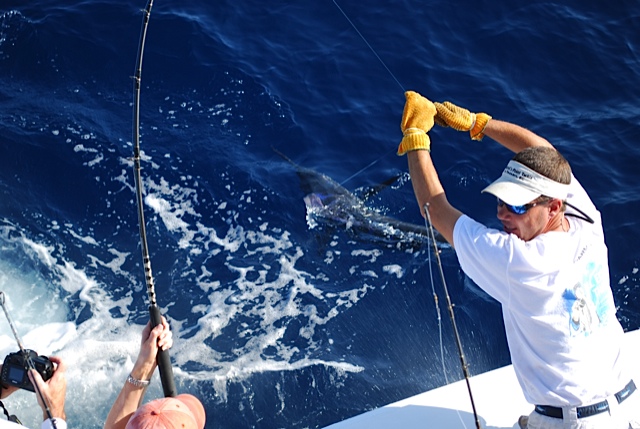
Later in the season, when white marlin and sailfish become more common, one of those lures may get switched out to a ballyhoo, depending on what the goals for the trip are. Murphy said he will get roughly half of his blue marlin bites on those short rigger lures, with the other half coming throughout the spread. Most important, however, the Syked Out will always pull two double-mullet dredges, one on either side of the cockpit. The weight and bulk of these dredges are handled by two LP-powered 80-pound class reels and are run from the cockpit, through a pulley on the outrigger, and into the spread. Both Beard and Murphy say the dredges are absolutely crucial to their success. They may well be right. In 2012, the crew caught nine blue marlin and had another six that were hooked up and taking lien before throwing the hook or jumping free.
Murphy stresses that he keeps his drags light. On the lures, he will push 15 to 18 pounds of drag at full, while the dink rods get a mere three to four pounds. When a medium-sized or larger marlin inhales a circle-hooked bait on 30-pound line, it’s all about boat handling and communication, and it’s obvious Murphy and Beard have figured out that part of the equation.
For the recreational anglers who own their own outboard-powered boats, blue marlin are still well within reach. Most weekend fishermen carry lures for marlin in case conditions are just right when the go offshore, but most taking center consoles to the Gulf Stream are looking for dolphin, blackfin tuna and wahoo first. Still, it’s fairly easy to deploy a spread of four to six “baitless” lures and give it a shot.
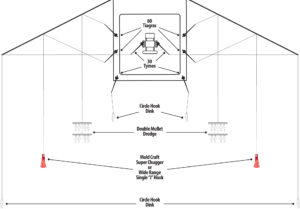
Black Bart and Aloha lures are the most popular in the area, with Pakula lures being a distant third. Several seasons ago the Pakula “Goblin” was the most productive lure in South Carolina tournament fishing, but Barts and Alohas remain the most-consistent producers. Most lures are rigged with a single, stainless-steel hook on a cable trace behind the lure’s head. In front of the lure is a heavy monofilament leader, up to 25 feet long. All the mate has to do is clip the rig onto a 30-wide or bigger outfit. Again, the biggest lures should go closest to the boat. A blue marlin isn’t the least bit shy about attacking a giant lure, sometimes mere feet away from turning outboard propellers!
Once you’ve put your time in and hooked a blue marlin, the big question is what to do next. As Murphy said, fighting one of these behemoths is often more about boat handling than just cranking power.
On a larger, diesel boat, captains have to choose between backing down and “quartering” on the fish. Quartering means running on a heading that’s at times almost parallel to the swimming marlin so the angler can get line back on the reel more quickly. In a center console, the angler can move to the bow, and the captain can simply give chase.
Either way, getting the fish to the boat requires the utmost collaboration between captain, mate and angler. He line has to stay tight throughout the battle or the fish will most likely come unhooked. When the fish is next to the boat, it’s time for a quick photo opportunity and a release. There is no point in taking home one of these creatures, aside from perhaps a very mature one in a tournament.
With a circle hook and a light leader, most mates simply cut the mono as close to the hook as possible. With a lure and a larger hook you should at the very least attempt to get your hardware back; just try to cause as little damage to the fish as possible. Never try to bring a live blue marlin into the boat with you. The only parties that might benefit from such practices are doctors and fiberglass repair shops.
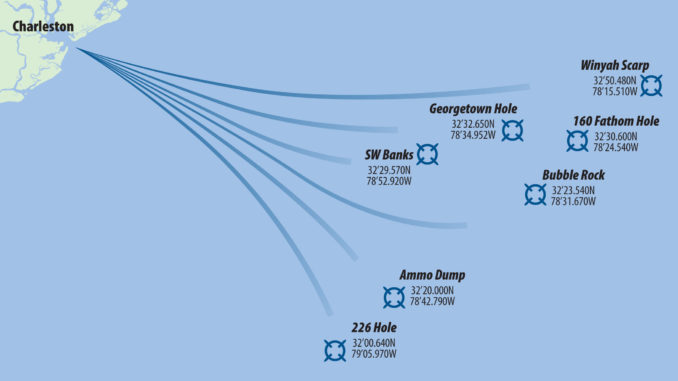 When it comes time to plan that fishing trip of a lifetime, you have no lack of options. Just be sure not to overlook what may be the easiest trip of all — one so close that it may well be hidden in plain sight. No more than four hours from anywhere in the Palmetto State, Charleston’s fishery is absolutely thriving.
When it comes time to plan that fishing trip of a lifetime, you have no lack of options. Just be sure not to overlook what may be the easiest trip of all — one so close that it may well be hidden in plain sight. No more than four hours from anywhere in the Palmetto State, Charleston’s fishery is absolutely thriving.
DESTINATION INFORMATION
WHEN TO GO/HOW TO GET THERE — Charleston anglers have an opportunity to tangle with a blue marlin just about any time they venture to the Gulf Stream. However, the season peaks for these fish in May, June and early July. Later on in the summer, there are still plenty of blues around, but anglers will encounter white marlin and sailfish more frequently. Charleston is one of the easiest ports to access on the entire east coast, served from the north or south by US 17 and from the Midlands or Upstate via I-26.
TACKLE/TECHNIQUES — Big trolling outfits from 30- to 80-wide are the norm, towing ballyhoo either behind Sea Witches or lures. Long, heavy monofilament leaders are the norm. Many fishermen targeting billfish and planning on catch-and-release have gone to circle hooks in 6/0 to 8/0 for terminal tackle.
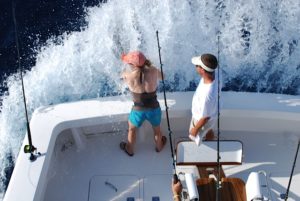
CHARTERS/FISHING INFO — Capt. Joe Murphy, Adamada Charters, 843-200-5299 or www.gofishsc.com/guide_services/Fishing_guides/adamada.htm; John Hurst, freelance mate-for-hire, 843-616-0849 or http://www.huntfishjohnhurst.com/; Charleston City Marina, 843-723-5098 or www.charlestoncitymarina.com; Haddrell’s Point Tackle, Mount Pleasant, 843-881-3644; Atlantic Game & Tackle, Mount Pleasant, 843-881-6900. Also, see Guides and Charters in Classifieds.
ACCOMMODATIONS — Charleston Convention and Visitors Bureau, 800-774-0006, www.charlestoncvb.com.
MAPS — John McWhite, ProFinder Charts, 910-512-6700, www.prochipusa.com; Capt. Segull’s Nautical Charts, 888-473-4855, www.captainsegullcharts.com; Maps Unique, 910-458-9923, www.mapsunique.com.




1 Trackback / Pingback